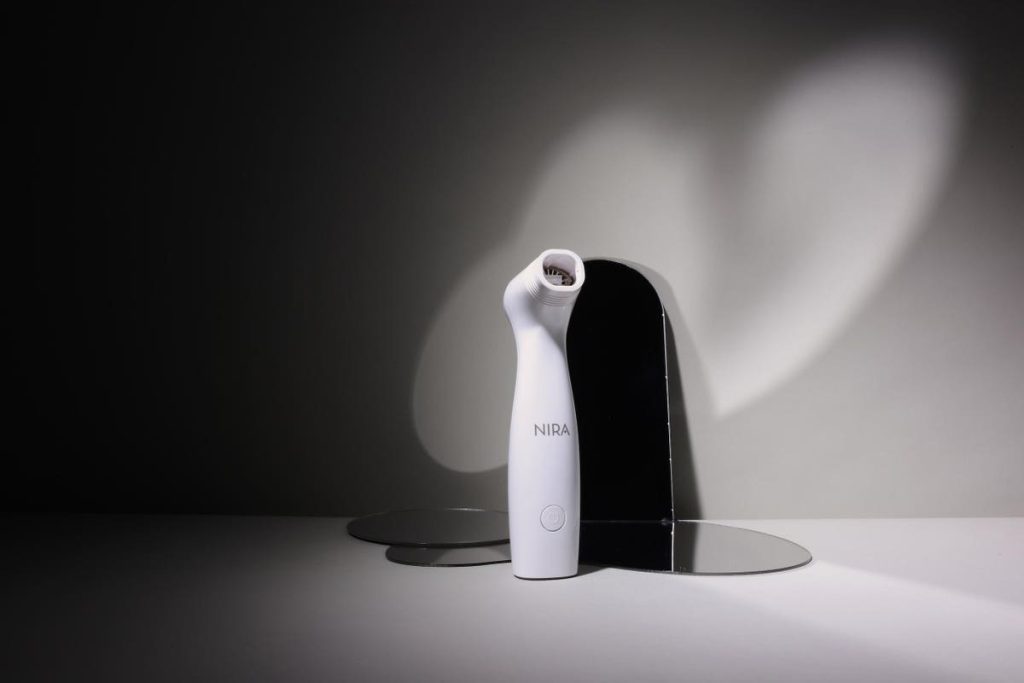If you have read any of my articles, you know that I am a huge proponent (and consumer) of non-invasive aesthetic technologies used to stave off the less desirable signs of aging including both in-office treatments and at-home devices. Since I have tried so many different types through the years (some more successful than others), I am always a little skeptical, especially when it comes to the efficacy of at-home devices. But sometimes I am pleasantly surprised.
After seeing some recent pictures of my almost 48-year-old face, I noticed that my deep-set eye lids were starting to fall and not get back up. A plastic surgeon friend recently told me that there was no doubt a lid lift was somewhere in my future especially since the skin will eventually sag to the point of impeding my vision. But I am not quite ready for surgery just yet. So, I looked around online to see if I could find any non-invasive treatment options. While I saw a few in-office treatments that looked promising, I came across NIRA, an at-home laser that caught my eye, which claims to be painless, is FDA-cleared, safe for all skin types, and clinically proven to reduce wrinkles in three months.
Founded by David Bean, a mechanical engineer who built his career on developing laser technologies, NIRA launched its flagship product, NIRA Precision in 2019. “After decades of developing and supplying leading dermatologists with laser chips for expensive and painful skin treatment systems, I decided it was time for something revolutionary: laser skin care that could deliver clinical-grade results at home without any of the pain, redness, or downtime.” Just recently, the brand launched its second device, NIRA Pro that offers a larger treatment head for more versatility.
Both NIRA lasers utilize a non-ablative and non-fractional laser technology that stimulates collagen production and promotes skin rejuvenation without damaging or removing the outer layer of the skin. “This type of laser delivers targeted thermal energy to the deeper layers of the skin, which stimulates collagen synthesis, improves skin texture, reduces wrinkles, and tightens the skin. With no impact on melanin in the skin, this technology is safe for all skin types and tones,” explains Bean. In comparison, most facial lasers for in-office or at-home are fractional or ablative. “Fractional or ablative lasers work by removing skin layers and destroying columns of tissue causing skin cells to die, which signals your body to produce more collagen to repair the damaged skin. This process often causes redness, scarring, inflammation, pain, and downtime.”
For consumers who may be new to the realm of aesthetic technologies, it can get confusing to know which treatment is appropriate or what in fact constitutes a laser. “LEDs, which are often mismarked as lasers, are low-level light therapy (LLLT) that require very long treatment times and may not produce the same level of results. Based on internal studies, NIRA’s patented laser technology is 200x more powerful than LED and 190x more powerful than competing at-home laser light technology,” shares Bean.
“NIRA’s patented technology works by using a non-linear fluence with a 1450 nm wavelength optimized for peak absorption, to penetrate into the papillary layer of the dermis (where your collagen and elastin cells are located,” continues Bean. “The dermal layer heats up to just under 45 degrees Celsius (113 degrees Fahrenheit), which is right above the level of heat shock protein (or collagen production), but below the pain threshold. This process stimulates natural collagen production, plumping and smoothing skin without pain, erythema (redness), and downtime.”
Both NIRA lasers can be used on any clean, dry skin, except for directly on the eyelids. “Many NIRA customers have reported improvements with wrinkles around the mouth (marionette lines), forehead, hands, chest, neck, and other skin blemishes (like dark circles around the eyes), and more. We plan to get further FDA clearance for these other treatment areas to guarantee broader results,” Bean tells me. “For possible enhanced results, you may treat twice a day, in the morning and the evening. We recommend waiting at least 1 minute before retreating to each area. Daily usage is recommended on an ongoing basis to maintain results.”
To get an outside opinion on NIRA’s technology, I tapped New York-based, board-certified dermatologist, Dr. Hadley King. “NIRA stands out in the realm of home devices because it’s a true laser. It’s a diode laser with wavelength 1450 nm, and it has clinically proven results. And the results last. Users can still see results 2-6 months later, even as use slows or stops,” she tells me. “By using NIRA for a longer duration compared to a single treatment, you are able to get more energy from NIRA, and therefore better results. A single in-office treatment would range from around $500 at the low end (needing more upkeep with repeated sessions every 4-8 weeks), to around $4000 for a more intense treatment (repeated sessions recommended every 1-2 years).”
I have been using both devices for a few months now and I can see a huge difference in my eyes and with the skin all over my face. Both my texture and tone have improved greatly. I suffer from vascular rosacea, and I have even noticed that the skin in my cheek area (where many dilated vessels reside) looks less ruddy and transparent. Both devices are easy to use, and I am pleasantly surprised at the results they deliver. I am excited to see what happens with continued use.
Read the full article here










